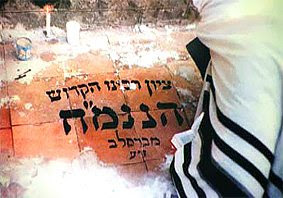
(Picture courtesy of HNN.co.il)
Yesterday, on Lag b'Omer, after perusing a fascinating e-article about Rabbi Moshe Chaim Ephraim (
The Bitul of the Degel Machane Ephraim), the Chassidic Master of the Ukrainian town of Sudilkov (1748-1800) who was also known as the author of "the Degel" as well as the grandson of the Baal Shem Tov HaKodosh, I was struck by a powerful insight into how one can distinguish between true divine servants and wannabes.
It came together with an e-encounter I just had with a certain Jew doing heroic medical care out in the African boondocks. I had been told about him on my recent trip to the U.S.A. to gather funds for supporting what
my Rebbe has been encouraging me to do for some time: Bris Mila (religious circumcision) for people that few others get to. It was suggested that this Jew might be a part of a team which makes a point, among other issues of hygiene, of promoting basic circumcision amongst the gentiles, which might provide me with abundant experience in the mechanics of my holy trade.
So I Googled.
He's been dubbed a
lamed vavnik (hidden Jewish saint) as well as a Father Teresa. This appears at first blush to be a tremendous Kiddush HaShem, a source of holy pride for the Jewish people, since he calls himself Orthodox in his devotion to Torah. Yet when I began my email with a question about how he fares out there as a Yid, all alone, he offered the following:
"Problem is that I work all the time and see patients on Shabbat and people with a different view of Pikuach Nefesh (the law about abrogating Shabbos restrictions in order to Save a Soul) are not helpful.""Different view?"
He replied:
"I see going to clinic on Shabbat to see routine cases as Pikuach Nefesh. Actually, there is no doubt in my mind about that."Hmm. I couldn't hold back:
"You speak as a man of conviction and devotion to a higher cause, which seems intimately tied up with Judaism. Yet it's unclear what that has to do with the authentic tradition of Torah law. You said your view of Pikuach Nefesh is 'different' than others, but avoid explaining what that has to do with Halacha (Torah Law). Now you add that you have 'no doubt' about the Divine value of this. Well my friend, this tells me absolutely nothing about the truth!"
Now the good doctor spoke straight:
"Please excuse, but I feel it's best to end our conversation!"
Fascinating how world saviors defend themselves, no? I found it an unbelievable parallel to the present visit of the Pope in the Holy Land. Isn't there somewhere way back in his religious tradition something about another talented Jew who had "no doubt" about the righteousness of his abrogating Torah Law??
It's also providential that those lines were written on no less a day than Lag b'Omer and when I read about the Degel.
That is, according to that article, the gist of the Degel's teachings is about the mystical meaning of the Hebrew term
Mah, which Moshe used in response to the Israelite criticisms about his and his brother Aharon having personal agendas in facilitating the Exodus (par. Beshalach 16, 7). He exclaimed: וְנַחְנוּ מָה, "what are we?!" as the two brothers threw themselves face down to the earth.
One might think this was an expression of shame and helplessness. But the Degel teaches the absolute opposite. It was a supremely positive, spiritual achievement, known as
bitul, self-nullification. Moshe's response to questions about his motives was not to dodge them and certainly not to wax on about his conviction, but to utterly subsume himself into G-d's reality.
There are several ways to spell out the letters in the main name of G-d, continues the Degel. One of those יוד- הא- ואו- הא)) is based on the use of the letter א, alef, which equals 45, the numerical equivalent of מה,
Mah. This offers an amazing parallel to what the father of formal Jewish mysticism, the Arizal, teaches about the importance of concentrating on this particular permutation of the Name while reciting the blessings of
Sefiras HaOmer (the counting of the period between Pessach-Shavuous, which is/was the essence of the Exodus). Accordingly, we should understand that human beings are composed primarily of blood, דם and when you add to this the א (numerically equaling one, which only G-d is, and pronounced
alef, which is associated with the pharse “
Alufo Shel Olam” – the Chief of the World”), you get א-דם, human, which numerically equals 45, the same as מה! That’s why this version of the Divine Name is spelled with alefs.
The implication of this powerful teaching is that when one comes to
bitul, positive self-nullification, only then does he become a truly heroic human being; a pure image of G-d.
But that's not all. This truth was so real to Rebbe Moshe Chaim Ephraim that we see it etched into his very being. For his first name was Moshe and the Divine sphere associated with the original Moshe is known as the quality of Netzach, which is also associated with the 32nd day of the Omer in it's being a repair of the sphere Netzach sh'b'Hod… which just "happens" to be his Yahrzeit (the anniversary of his passing from this world)!!
Now for my two cents.
It's accepted tradition that Rebbe Shimon Bar Yochai, who's Yahrzeit is the 33rd day of the Omer, known as Lag b'Omer, which parallels the quality of Hod sh'b'Hod, was the reincarnate of Moshe Rabbeinu. So which is it – Rabbi Moshe Chaim Ephraim or Rabbi Shimon; the 32nd or 33rd??
The key, I believe, is in understanding the relationship between the first 32 days of the Omer and the last 17, which are famously associated with their numerical equivalents לב טוב, Lev (32) Tov (17), Good Heart. BOTH elements are crucial for achieving
bittul. There needs to be heart, profound personal feeling, but also objective goodness.
As the Mishna in Avos states (6:3): אין טוב אלא תורה, "there's no good other than Torah." This doesn't mean that someone who hasn't learned Torah has no relationship with good. In fact, the first sparks of goodness are to be found within the heart, as per the Talmudic dictum: רחמנה ליבה בעי, G-d wants the heart (Sanhedrin 106:B). Wants – but is not satisfied by only it. Rather, while truth begins within the heart, it can never find pure expression without the objective guidance of Torah.
Like the world says, "paths paved with good intentions" can lead in many directions. The
Nesivos Sholom on Avos (4:21) explains that this is the precise meaning of the phrase edified by the Mesilas Yesharim as the foundation of Jewish ethics: "This world is likened to a corridor before the Next World; prepare yourself in the corridor in order that you shall enter the grand palace".
Why not say "as an entrance to"? Rather, doing so wouldn't have alluded to the very real danger of entering the wrong palace! It's not enough to cultivate spiritual movement in this world; it must be movement in the right direction.
And so we learn of two great Tsadikkim, true saints, Rebbe Shimon and Rebbe Moshe Chaim Ephraim, who were pure embodiments of the one absolutely selfless teacher, Moshe Rabbeinu, being associated with the 32nd and 33rd days with of the Omer. For this is the formula for life:
Where the Lev ends, the Tov begins
As it's written (Deut.10): "And you should circumcise the foreskin of your hearts and the back of your necks should stiffen no longer."
The back of our necks means these last 17 days of the Omer, the last period before receiving the Torah anew on Shavuous, the commemoration of the time when the "G-dhead" revealed absolute truth to Moshe Rabbeinu.
Normally this truth appears stiff. But after seeking it deeply within the heart, for 32 consecutively meaningful days, it suddenly presents itself as progressively accessible. F-i-n-a-l-l-y we can make the radical shift between our personal sense of truth calling the shots and letting G-d's truth do so.
Is there a better time for becoming a Mohel?








.jpg)


.jpg)
























